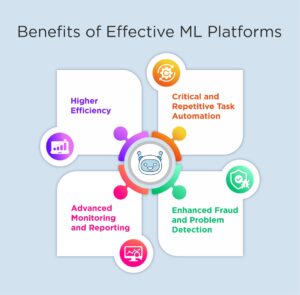Artificial intelligence (AI) and machine learning (ML) have become two common innovations that organizations are integrating quickly. With enhanced efficiency and reliable predictive analytics, these technologies have unlocked numerous opportunities for businesses to grow and stay competitive. Nevertheless, one of the biggest hurdles data scientists and machine learning engineers face is choosing and utilizing the appropriate ML platforms.
Reportedly, the global machine learning industry valuation stands at $105 billion in 2025, which is set to surpass $568 billion by 2031. The stats depict how ML adoption is increasing across different sectors. However, diverse challenges arise while developing machine learning models, such as compute resource management and environment consistency.
Let us understand how data scientists can eliminate these challenges by choosing the appropriate machine learning model development platforms. Let’s get started…
What are Machine Learning Platforms?
Machine learning platforms offer a series of resources and tools to build and deploy machine learning models and applications for business advancement. Also known as ML Toolkit, these platforms assist data scientists and machine learning engineers in effectively building models, managing the entire development lifecycle, from data preparation to testing and total integration.
Alongside that, choosing the right ML platform also enables data scientists to process big data seamlessly for model formulation. AI-driven automation and streamlined execution of each development stage are the core characteristics of such platforms. Primarily, these platforms offered highly code-based model development opportunities. However, with advanced technologies, ML toolkits are able to provide a low-code and no-code development experience.
Cloud integration is another attribute of ML platforms that empowers data scientists to develop models and applications without thinking much about storage complexities.
Types of ML Platforms:
We can categorize machine learning platforms into four broad types:
High-level Platforms:
These are the most advanced and sophisticated platforms with features that assist data scientists in building models with higher efficiency and lower risk. Automation is a core feature of such platforms that helps in problem detection, data preparation, and algorithm configuration.
Cloud-based IDEs:
This type of machine learning platform works as an integrated development environment (IDE) with cloud capabilities. Its powerful cloud-based virtual machines (VMs) enable data scientists to create models faster and more easily.
Semi-specialized Platforms:
These platforms are mainly used for text and image-focused models. Developers need to provide training data to these platforms for automatic ML model development. For text-based models, inputs are text. On the other hand, for vision-based models, inputs are either images or videos.
Self-hosted Studios:
These platforms are installed and hosted on developers’ own machines. Due to their hosting differences, these platforms are not highly preferred for advanced development. They are mostly open-source ML toolkits that let data scientists utilize custom codes with the opportunity to export ML pipelines as Python code.
Why Do Data Scientists Need to Choose Appropriate ML Platforms?
As mentioned previously, effective machine learning platforms support the entire model and application development lifecycle, which is highly beneficial for data scientists. The foremost benefit is meeting the predefined goals that help achieve business progression as well.
Let us discuss a few aspects to understand why choosing appropriate machine learning platforms is essential-
Higher Efficiency:
Machine learning platforms allow model building with higher efficiency, which makes an application more effective and robust. These platforms enable data scientists to pay attention to each stage, considering all the requirements. Systematic model development also leads to error-free business operations.
Critical and Repetitive Task Automation:
ML platforms automate critical and repetitive tasks within model building. Such an approach helps data scientists save time and resources. Alongside that, it eliminates the possibility of human error, which can lead to challenging situations.
Enhanced Fraud and Problem Detection:
Machine learning models are created based on a vast number of datasets. ML toolkits support identifying fraudulent or misleading information with sophisticated governance tactics. Aside from that, these platforms also help in detecting errors and drawbacks in the model development process, strengthening the development lifecycle.
Advanced Monitoring and Reporting:
Machine learning platforms enable advanced monitoring and reporting alongside automation. Hence, every progression and error get reported while developing models, allowing the developers to plan and adopt change whenever it is required. In short, appropriate ML platforms can help establish an agile development framework.
Key Considerations While Choosing Effective ML Platforms?
- Ensure the Platform Offers Easy Data Accessibility: Machine learning model development requires easy and continuous data accessibility. Structured and clean data is a must that leads to robust model development. Hence, if there are any difficulties in data format, structure, and storage, data scientists are suggested to ignore such platforms.
- Choose the Best Technological Support with Advanced Integrations: Efficient model development seeks advanced technological support and integrations. These attributes enable machine learning engineers to manage each stage of the development process, eliminating errors.
- Assess Collaboration Parameters Between Data Engineering and Data Science: Strong collaboration between data engineering and data science helps in addressing data accessibility difficulties, such as data format issues and constraints with data bandwidth. Furthermore, such an approach also strengthens computing and deployment endeavors alongside governance. Therefore, selecting an ML platform that allows developers to combine data engineering and science effortlessly will be advantageous.
- Consider the Opportunities for Agility and Flexibility: Automation is a common attribute of ML platforms. However, many service providers fail to sustain flexibility while automating most of the development tasks. Hence, assess flexibility opportunities before determining the right platform for machine learning operations.
- Evaluate Compatibility Between Your Model Goals and Those of the Platform You Are Choosing: The most crucial element to evaluate before choosing the right platform is whether it will help the developers achieve their predefined objective. The development process may encounter several roadblocks if there are compatibility issues between the service provider and the enabler.
Best Machine Learning Platforms that Can Actually Benefit Data Scientists:
Databricks:
Databricks is one of the leading ML platforms that focuses primarily on enterprise-scale data management. Its centralized framework enables integration with top-notch tools and features. Additionally, it has REST-API-driven model deployment and self-service data pipelines.
This ML platform offers a 14-day free trial and a pay-as-you-go plan. So, users can pay only for what they use.
Amazon SageMaker:
With features like fully managed workflows and infrastructure, SageMaker is a cloud-based machine learning platform. Notably, it enables access to vast numbers of structured and unstructured databases for model development. Furthermore, it deploys different models for specific roles, such as no-code frameworks for business analysts and IDEs for data scientists.
Users can get started with a free plan and later continue with the pay-as-you-go format.
TensorFlow:
TensorFlow is one of the best open-source ML platforms with advanced features for managing MLOps. It enables production-ready ML pipelines with opportunities for on-premises and cloud-based deployment. Moreover, the toolkit offers responsible AI facilities for robust data preparation that address data bias.
Data scientists and machine learning model developers can use it for free.
Microsoft Azure Machine Learning:
Azure Machine Learning provides end-to-end cloud integration to support the entire machine learning model. It enables Machine Learning Studio, which allows data scientists to create models with a no-code designer. Additionally, its MLOps tools help automate workflows and optimize model deployments.
It also has a pay-as-you-go model, and most of the services require no additional charges once subscribed to Azure facilities.
Wrapping Up!
Opting for the right machine learning platform is essential for ML engineers while developing robust models and applications. In this regard, assessing the features and facilities of a particular platform, such as data accessibility, compatibility, flexibility opportunities, and others, is important.
Since machine learning and ML-based applications are becoming none less than a trend for companies, it is crucial to choose facilities that help seamless and robust development. Such an endeavor will not only support building effective applications but will also contribute to optimized business operations.
Follow our blog updates and stay informed of the evolving technological world!
F&Qs:
Q1. Which platform is best for ML?
Answer: The best ML platform offers advanced technology and scalability opportunities. However, it depends on the requirements of the model or application that has been developed. Databricks, TensorFlow, AWS SageMaker, etc., are among the best machine learning platforms.
Q2. What are the 4 types of machine learning?
Answer: Four types of machine learning are reinforcement learning, supervised learning, unsupervised learning, and semi-supervised learning.
Q3. Does ML need coding?
Answer: Yes, ML requires coding, especially for advanced model development and applications.
Also Read:
Data Analytics and AI Machine Learning: Know the Difference
An Overview of Machine Learning. What can machine learning be used for?
Data Splitting in Machine Learning – Meaning, Methods, and Importance



